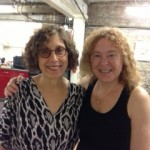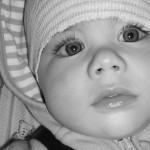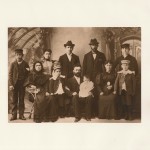 Here I am in New York (actually Brooklyn) yesterday morning, with my agent, Susan Golomb. Along with being a warm, lovely person and an insightful editor, Susan is a mega agent; her list includes Jonathan Franzen and Rachel Kushner. I did not get Susan to consider representing me because I knew any of these people … nor was I best friends with her cousin or her dog walker. Plus, I live in San Diego, about as far from New York as you can get and still be in the continental U.S. But I heard back from her – and from half of the 12 agents I approached – within a few weeks after sending a one-page query letter.
Here I am in New York (actually Brooklyn) yesterday morning, with my agent, Susan Golomb. Along with being a warm, lovely person and an insightful editor, Susan is a mega agent; her list includes Jonathan Franzen and Rachel Kushner. I did not get Susan to consider representing me because I knew any of these people … nor was I best friends with her cousin or her dog walker. Plus, I live in San Diego, about as far from New York as you can get and still be in the continental U.S. But I heard back from her – and from half of the 12 agents I approached – within a few weeks after sending a one-page query letter.
It was a really good query. And it took me about a year to write. My particular challenge was, how should I introduce my novel … with the contemporary story, which kicks off the action? with the historical story and its rich setting? with the spark for the book, a minor character in The Big Sleep? You’ll see that in the query I came up with, I actually managed to get all three of those things into the first paragraph. That did not happen in my first draft. Or my second or third.
Whatever your unique challenges, if you’ve written a novel of any complexity, you face the same core issues in writing a query: You need to reduce your novel of 75,000 words or more to one measly page in which you mention key characters, plot elements, and themes. And this radically pared-down piece of prose nevertheless needs to give a taste of your sparkling narrative voice. And, by the way, you want to throw in that you are willing to do the agent’s dishes for the rest of your life, or chauffeur her kid to school … except you restrain yourself and leave that part out.
But you’ve already made it through Rules 1-4. You’ve gone toward what scares you. You’ve done the work. You’ve been open to feedback, whether it’s just your own or you’ve been in a writers group. You’ve been a pro about revising. So you can handle …
Rule #5. Write a strong query.
Here are some tips.
Give your query the time it deserves. Write a draft. Then show it to people and get feedback. This goes even for those who aren’t into writers groups. Your query is a marketing document, and you need to know how it comes across. Once you get feedback, set the query aside and let the ideas simmer. Then go through the cycle – write, get feedback, and let simmer – again. And again.
By the way, for a novel, unless you’re a celebrity, you shouldn’t approach agents until you have a completed manuscript to send them. So you can start working on a query when you’re coming into the home stretch on your book.
Use basic query structure. You’ll probably find multiple, conflicting ideas about what that is. Here’s what I suggest:
– Introductory paragraph, which may start with some personal note about why you’re approaching this particular agent and then gives a capsule description of your book. You’ll notice that in mine, I slipped in the length of my ms., which is useful information and also let the agent know the book was completed.
– Plot summary – I’ve read that this should be just one paragraph; however, because of the historical and contemporary threads in my book, I did one for each thread.
– Relevant background about you.
Make it professional. In addition to the basics like demonstrating your familiarity with conventions of spelling and grammar, do not use a microscopically tiny font. In these days when most agents accept electronic queries, you can probably get away with going a teensy bit over one page. That does not, however, mean you can pack in three pages worth by using a 9-point instead of the standard 12-point font. It’s obvious.
Here’s the basic query I sent – often leading off with something specific to the agent I was approaching. By the way, you’ll notice that my working title for the book was not The Tin Horse. That happens.
***
I am seeking representation for An Intelligent Jewess, a literary novel (100,000 words) that was inspired by a marginal character in The Big Sleep, a keenly observant young woman described as having “the fine-drawn face of an intelligent Jewess.” Set primarily in the 1920s and 30s, my novel gives “the Jewess” a name, Elaine Greenstein, and takes place in her Los Angeles, the little-known Jewish immigrant mecca of Boyle Heights. And it explores her mysteries of identity and family—sparked by her discovery, at age eighty-five, of a clue to what happened to her twin sister, who disappeared when they were eighteen.
Born in 1921, Elaine grows up in Boyle Heights, a neighborhood east of downtown Los Angeles that was home to more than 75,000 Jews (site of the original Canter’s Deli and Max Factor’s barber shop) between the First and Second World Wars. Elaine’s Papa preaches the American Dream, despite being stuck as a salesman at Fine’s Fine Footwear, and Mama schemes to get money for her girls’ school outfits via her savvy at cards. Elaine feels her fiercest love and most bitter rivalry toward her fraternal twin, Barbara. Elaine is the brainy sister, Barbara a bold rule-breaker who shoplifts groceries to help their pal, Danny, during the Depression. Naturally, thrilling Barbara becomes Danny’s first love, while Elaine pines for him. Soon greater forces rip the childhood friends apart. At home in their Jewish enclave yet close to neighborhoods where rental signs say “No Jews or Dogs”—and hearing dire news from Europe—Danny embraces Zionism. Elaine is determined to be Jewish and American. And Barbara wants out. After a blowup when she and Elaine are eighteen, she flees and is never heard from again.
When my novel opens, Elaine is eighty-five. She has raised her children, buried her husband, and had a career as a leading progressive attorney (in The Big Sleep, the Jewess is reading a law book). Her life’s work is over. Then she stumbles on a decades-old clue to Barbara’s whereabouts. In contemporary chapters woven through the novel, she follows Barbara’s trail. But before Elaine can face her sister again, she must revisit their past.
Although An Intelligent Jewess is a literary novel, its spark came from my roots in mystery fiction. I am the author of five mysteries published by Berkley, including the Shamus-nominated Death in a City of Mystics, set in Israel. I am also an arts journalist and have published more than 300 articles in the San Diego Union-Tribune, Dance Magazine, and elsewhere.


